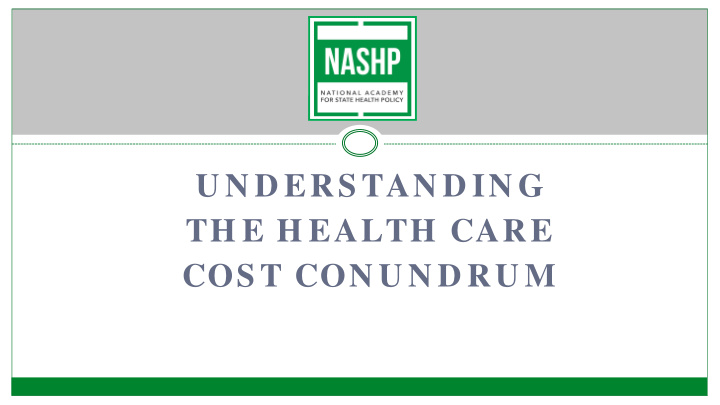



U N D ERS TAN D IN G TH E H EALTH CARE COS T CON U N D RU M
The Facts Health care in the US is 18% of GDP One of every three new jobs is in health care , 2007-2017 US spends two times what other wealthy countries spend , but has worse outcomes
What’s Driving Spending? ~30% of health care spending is wasteful IOM (Institute of Medicine). 2013. Best care at low er cost: The path to continuously learning health care in Am erica . Washington, DC: The National Academies Press.
Price and intensity have been the primary drivers of health care spending . Source: Factors Associated With Increases in US Health Care Spending, 1996-2013 JAMA. 2017;318(17):1668-1678. doi:10.1001/jama.2017.15927
Health care consolidation trends highly concentrated Source: DM Cutler, F Scott Morton, Hospitals, Market Share, and Consolidation, JAMA. 2013;310(18):1964-1970.
Health care consolidation trends % of markets that are highly concentrated: 65% of specialty physician markets 57% of insurer markets 39% of primary care markets Source: Fulton, BD. Health Care Market Concentration Trends in the United States: Evidence and Policy Responses. Health Affairs. 2017;36(9):1530-1538.
Hospital Consolidation Higher Prices Hospital consolidation Author/Year Result leads to significantly Dafny (2009) Merging hospitals had 40% higher prices in higher prices than non- concentrated markets. merging hospitals Haas-Wilson, Garmon Post-merger, Evanston NW (2011) hospital had 20% higher Estimated price prices than controls increases range d from Tenn (2011) Summit/Sutter prices 20-40% increased 28% - 44% compared to controls Source: Gaynor M, Town R, The impact of hospital consolidation – update, Robert Wood Johnson Foundation, The Synthesis Project, ISSN 2155-3718 (June 2012).
• Patient outcomes are worse in more concentrated markets, where hospitals or physicians face less competition • Hospital ownership of physician practices led to higher readmission rates and no better quality measures
Inpatient hospital stay charges have increased faster for private insurance than for Medicare or Medicaid . Average inflation-adjusted, standardized payment rates per inpatient hospital stay, by primary payer, 1997-2015 $25,000 Private insurance Medicare Medicaid $19,975 $20,000 $15,000 $11,840 $11,868 $10,000 $11,186 $9,379 $9,071 $5,000 $- 1996 1997 1998 1999 2000 2001 2002 2003 2004 2005 2006 2007 2008 2009 2010 2011 2012 2013 2014 2015 Note: The average payment rates were computed as if each primary payer paid for all non-maternity adult stays in a given year. Payments were adjusted for inflation and standardized across payers in terms of patient’s age, sex, race/ethnicity, geography, household income as a percentage of the federal poverty level, conditions, charges, length-of-stay, and whether or not a surgical procedure was performed. They were not standardized for changes over time in the bundles of treatments and services provided during inpatient stays. Source: Thomas M. Selden analysis of AHRQ’s Medical Expenditure Panel Survey for the Kaiser Family Foundation. Update of earlier analysis, available here: https://www.healthaffairs.org/doi/abs/10.1377/hlthaff.2015.0706
The Cost Shifting Challenge Underpayment by Medicare and Medicaid Cost shift to other payers Community b enefit Would equalizing public and private payment rates reduce cost shift? One recent study* found hospitals receiving an unexpected 10% increase in Medicare payment rates… • Added new technology • Increased nursing staff • Increased payroll by 1/ 3 * Skinner J, Chandra A. Health Care Employment Growth and the Future of US Cost Containment. JAMA. 2018;319(18):1861–1862. doi:10.1001/ jama.2018.2078
Drug spending has grown rapidly in recent years , but most health dollar s are spent on hospitals and physicians . Source : Kaiser Family Foundation analysis of National Health Expenditure (NHE) data from Centers for Medicare and Medicaid Services, Office of the Actuary, National Health Statistics Group
The share of household budgets devoted to health expenses has been increasing , 2002-2012 . Average portion of household budget devoted to health (nonelderly families), 2002-2012 6.0% Total health expenses: 5.2% 5.0% 4.4% 4.0% Insurance premiums: 3.1% 3.0% 2.0% Out-of-pocket costs: 2.1% 1.0% 0.0% 2002 2003 2004 2005 2006 2007 2008 2009 2010 2011 2012 Source : Kaiser Family Foundation analysis of Consumer Expenditure Survey
Spending on deductibles / coinsurance have far outpaced wages, while copayments have fallen . Cumulative increases in health costs, amounts paid by insurance, amounts paid for cost sharing and workers’ wages, 2005-2015 200% 176% 150% 100% 67% 50% 29% 0% -38% -50% 2006 2007 2008 2009 2010 2011 2012 2013 2014 2015 2016 Source: Truven Health Analytics MarketScan Commercial Claims and Encounters Database, 2005-2015; Bureau of Labor Statistics, Seasonally Adjusted Data from the Current Employment Statistics Survey, 2006-2016 (April to April).
Recommend
More recommend